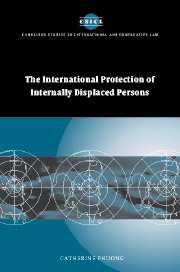Book contents
- Frontmatter
- Contents
- Acknowledgments
- Table of cases
- Table of treaties and other international documents
- List of abbreviations
- Introduction
- 1 Internally displaced persons and refugees: conceptual differences and similarities
- 2 The legal protection of internally displaced persons
- 3 The institutional framework of protection for the internally displaced
- 4 Protection strategies for the internally displaced
- 5 Case study: internal displacement in Bosnia and Herzegovina
- 6 Reconceiving sovereignty and intervention
- Conclusions
- Annex 1: The Guiding Principles on Internal Displacement
- Bibliography
- Index
- CAMBRIDGE STUDIES IN INTERNATIONAL AND COMPARATIVE LAW
4 - Protection strategies for the internally displaced
Published online by Cambridge University Press: 17 July 2009
- Frontmatter
- Contents
- Acknowledgments
- Table of cases
- Table of treaties and other international documents
- List of abbreviations
- Introduction
- 1 Internally displaced persons and refugees: conceptual differences and similarities
- 2 The legal protection of internally displaced persons
- 3 The institutional framework of protection for the internally displaced
- 4 Protection strategies for the internally displaced
- 5 Case study: internal displacement in Bosnia and Herzegovina
- 6 Reconceiving sovereignty and intervention
- Conclusions
- Annex 1: The Guiding Principles on Internal Displacement
- Bibliography
- Index
- CAMBRIDGE STUDIES IN INTERNATIONAL AND COMPARATIVE LAW
Summary
Internal displacement has been recognised as one of today's major humanitarian problems, but the key issue of protection has not always received appropriate attention, in spite of the view that ‘the main problem is not assistance but rather protection for internally displaced persons’. The Vienna Declaration and Programme of Action adopted at the end of the World Conference on Human Rights held in 1993 mentioned the case of the internally displaced as a human rights matter. Internally displaced persons are indeed often among not only the most destitute, but also the most vulnerable to human rights abuses. They face problems of physical safety, lack of food and water, access to health and other social services, and are often separated from their family.
Whereas the previous chapter put the focus on UN agencies' stated approaches to internal displacement, the present chapter examines field activities and the extent to which they reflect some of the flaws in the UN's understanding of the problem of internal displacement. It examines protection strategies implemented on the ground by a variety of international actors such as humanitarian agencies, peacekeeping forces and human rights field monitors. Such strategies assume that an international presence has already been established in the country concerned with or without the consent of the government. The chapter evaluates the efficiency of measures undertaken to protect internally displaced persons from human rights violations, including forced displacement.
- Type
- Chapter
- Information
- The International Protection of Internally Displaced Persons , pp. 117 - 154Publisher: Cambridge University PressPrint publication year: 2005



